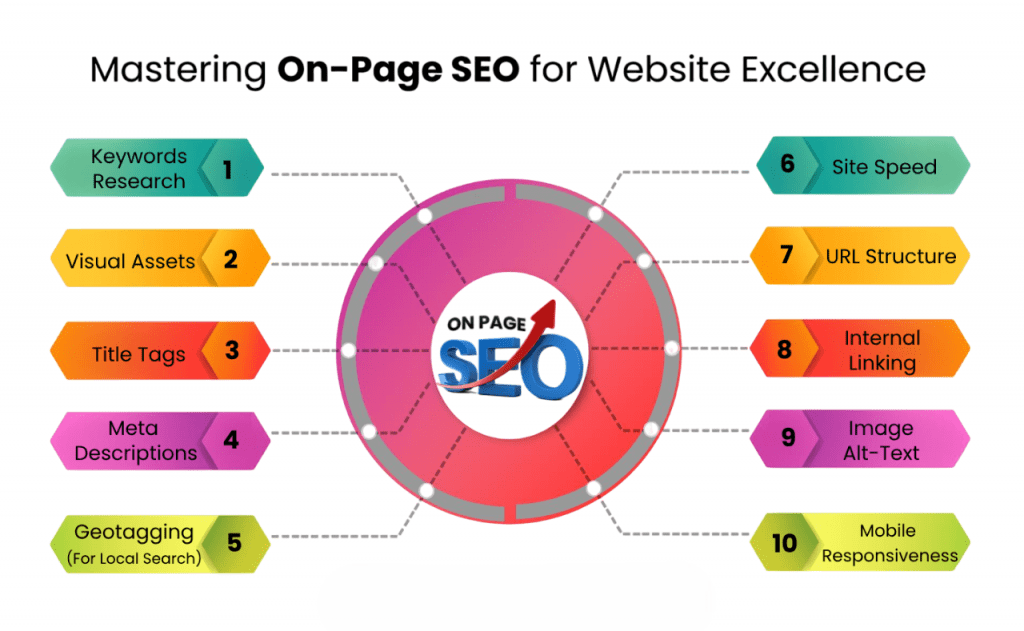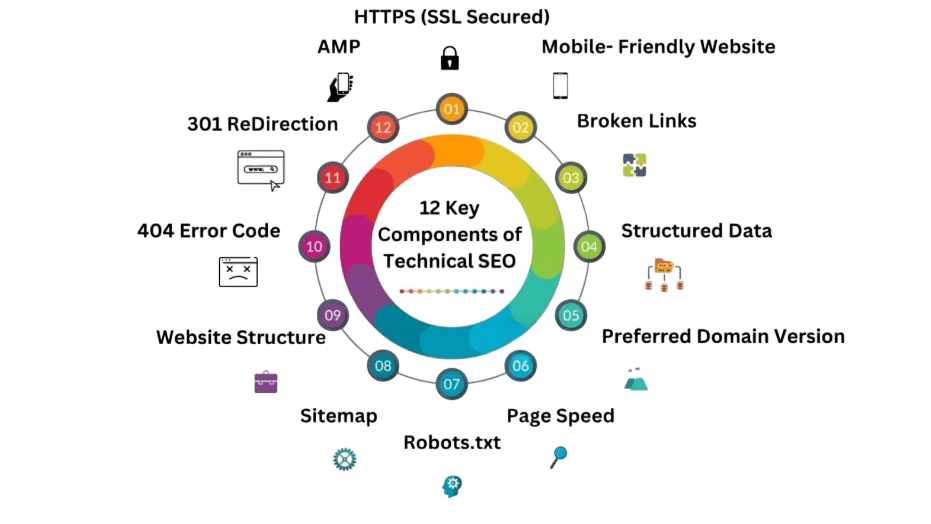
- Introduction and What is SEO?
- Why SEO Matters
- How Search Engines Work
- Key Components of Search Engine Optimization
- On-Page SEO
- Off-Page SEO
- Technical SEO
- Keyword Research
- Content and SEO
- Mobile SEO and User Experience
- Measuring SEO Performance
- Search Engine Optimization Tools
- Common SEO Mistakes to Avoid
Introduction and What is SEO?
Search Engine Optimization, or SEO, is one of the most essential elements of digital marketing. Whether you are building a personal blog, launching an online business, or managing a corporate website, understanding SEO is crucial for increasing visibility, attracting traffic, and ultimately growing your audience core skills developed through Digital Marketing Training, where learners master keyword research, site optimization, and content strategy to drive organic growth across digital platforms. This article will walk you through the basics of SEO in a simple, practical way. SEO stands for Search Engine Optimization. It refers to the practice of optimizing your website and its content so that it appears higher in search engine results pages (SERPs) when users search for related terms. The goal of SEO is not just to attract more visitors but to attract the right visitors who are actively searching for the products, services, or information you provide.
Ready to Get Certified in Digital Marketing? Explore the Program Now Digital Marketing Online Training Offered By ACTE Right Now!
Why SEO Matters
Improving user experience requires better site structure and quality content. Unlike paid advertising, SEO provides an affordable, long-term way to market online that brings in steady, free traffic. In today’s digital landscape, businesses that want to grow sustainably rely on SEO to build authority in their industry a long-term strategy often amplified by Outstanding Social Media Campaigns, where brands integrate keyword-rich content, platform-specific engagement, and backlink-generating tactics to reinforce visibility, credibility, and organic reach across search engines and social channels. Organic search leads help reduce dependence on costly marketing channels. This makes SEO a key part of any digital marketing plan, allowing companies to connect with potential customers. By achieving higher search rankings, organizations can build trust and credibility. They improve the overall user experience by refining site structure and enhancing content quality. SEO offers a cost-effective way to market online and generate continuous, free traffic. Strategic SEO investments help businesses establish authority, consistently attract quality leads, and lessen reliance on expensive marketing channels, making it vital to any digital marketing strategy.
How Search Engines Work
To understand SEO, you must first understand how search engines like Google operate. The process involves three main steps: crawling, indexing, and ranking core mechanics that intersect with the Top 10 Benefits of Social Media Marketing, where strategic content distribution across platforms like Instagram, LinkedIn, and X (Twitter) boosts visibility, generates backlinks, and amplifies engagement signals that indirectly enhance search engine rankings and organic discoverability.
- Crawling: Search engines use bots (also called spiders) to scan the internet and discover new or updated content.
- Indexing: The content discovered is stored and organized in a giant database (index).
- Ranking: When a user enters a query, search engines evaluate and rank relevant pages based on over 200 factors, including relevance, quality, and user experience.
SEO is about optimizing your site so that it is easily crawled, indexed, and ranked by search engines.
To Explore Digital Marketing in Depth, Check Out Our Comprehensive Digital Marketing Online Training To Gain Insights From Our Experts!
Key Components of Search Engine Optimization
SEO can be broken down into several core categories: on-page optimization, off-page strategies, technical SEO, and content relevance each contributing to visibility and authority in search engines. These pillars intersect with What is Branding, where marketers learn to align keyword strategy with brand identity, leveraging branded and non-branded terms to enhance recognition, drive qualified traffic, and reinforce trust across digital touchpoints.
- On-page SEO: Optimizing individual pages on your site.
- Off-page SEO: External factors like backlinks and brand mentions.
- Technical SEO: Site performance, structure, and crawlability.
- Content: High-quality, relevant, and optimized content.
- Keywords: The terms people search for and how they relate to your content.
A well-rounded SEO strategy involves working on all these elements simultaneously.
On-Page SEO
On-page SEO is vital for improving website rankings. It optimizes various internal elements that help search engines understand and prioritize content. Key factors include creating strategic title tags with main keywords under 60 characters, writing compelling meta descriptions that encourage user clicks, and using header tags (H1, H2, H3) to organize content core responsibilities outlined in Digital Marketing Executive Job Description, where professionals are expected to implement on-page SEO best practices that enhance visibility, improve click-through rates, and ensure semantic structure for search engines. These elements contribute directly to organic performance and user experience.

A clean, keyword-integrated URL structure is essential. Thoughtful internal linking connects relevant pages within your site, which is also important. By placing keywords naturally throughout the content, titles, and headings, websites show relevance to search algorithms and improve user readability. Effective on-page SEO serves two purposes: it makes content easier to find for search engines and creates a more intuitive, engaging experience for website visitors.
Looking to Digital Marketing Training? Discover the Digital Marketing Expert Masters Program Training Course Available at ACTE Now!
Off-Page SEO
Off-page SEO is vital for building your website’s credibility and authority through external signals. By focusing on key activities like getting high-quality backlinks from trusted websites, generating social engagement, and fostering brand mentions, you can greatly improve your online reputation. While backlinks are still a strong ranking factor, you can also use guest posting opportunities to gain exposure and develop valuable connections across digital platforms a strategic approach emphasized in Digital Marketing Training, where learners explore link-building tactics, content syndication, and relationship-driven outreach to enhance SEO performance and industry credibility. Think of off-page SEO as managing your digital reputation. The more trustworthy and respected your website appears in the larger online space, the better search engines will rank your content. These external validation methods work together to show your website’s relevance, expertise, and reliability, which ultimately drives better visibility and increases organic traffic.
Technical SEO
Technical SEO focuses on the backend structure of your website and how search engine bots interact with it.
Key Elements:
- Site speed: Fast-loading websites offer better user experience and higher rankings.
- Mobile-friendliness: With mobile-first indexing, your site must work well on smartphones.
- Secure connection: HTTPS is a ranking factor. Make sure your site uses SSL.
- XML sitemaps: Help search engines understand the structure of your site.
- Robots.txt: Tells search engines which pages to crawl or avoid.
- Canonical tags: Prevent duplicate content issues.

Technical SEO ensures your site is easy to crawl and index, laying the foundation for all other efforts.
Preparing for Digital Marketing Job Interviews? Have a Look at Our Blog on Digital Marketing Interview Questions and Answers To Ace Your Interview!
Keyword Research
Keyword research is the process of identifying the search terms people use to find information related to your business a foundational SEO tactic enhanced by What is Sitecore, where semantic relationships, synonym mapping, and AI-driven analyzers help expand keyword coverage, improve relevance, and deliver personalized search experiences across enterprise-level digital platforms.
Steps to Effective Keyword Research:
- Brainstorm seed keywords related to your products or services.
- Use keyword tools to find search volume, difficulty, and related terms.
- Group keywords by intent:
- Informational: (e.g., “how to bake bread”)
- Navigational: (e.g., “Facebook login”)
- Transactional: (e.g., “buy running shoes”)
- Choose a mix of short-tail (broad) and long-tail (specific) keywords.
- Focus on low-competition, high-intent terms when starting out.
- Create original, high-value content that answers user queries.
- Use keywords naturally, without stuffing.
- Add images, videos, and infographics to enhance engagement.
- Maintain a consistent publishing schedule.
- Focus on E-E-A-T (Experience, Expertise, Authoritativeness, Trustworthiness).
- Use structured data (schema markup) to enhance how your content appears in search.
- Organic traffic: Visitors coming from search engines.
- Keyword rankings: Your position in search results for target keywords.
- Click-through rate (CTR): How often users click on your search listing.
- Bounce rate: Percentage of users who leave after viewing one page.
- Conversion rate: The percentage of visitors who complete a desired action.
- Backlink profile: Quality and quantity of external links.
- Google Search Console: Monitor site performance and fix indexing issues.
- Google Analytics: Track visitor behavior and traffic sources.
- Yoast SEO (for WordPress): Simplifies on-page SEO tasks.
- Ubersuggest: Useful for keyword research and SEO audits.
- AnswerThePublic: Generates keyword ideas from real user questions.
Optimizing content for the right keywords increases visibility and attracts qualified traffic.
Content and SEO
Content is at the heart of SEO. Without relevant, engaging content, your optimization efforts won’t succeed.
Key Content SEO Tips:
Well-optimized content attracts traffic, builds trust, and encourages backlinks all vital to SEO.
Mobile SEO and User Experience
In today’s digital world, search engines focus on user experience, particularly for mobile users. To succeed online, businesses need to follow mobile SEO best practices. A responsive design that works well on all screen sizes is essential. This ensures that websites look and function smoothly on different devices. It’s also crucial to avoid annoying pop-ups and provide text that is easy to read without zooming mobile UX principles that directly impact Email Marketing, where responsive design, unobtrusive pop-up behavior, and legible typography ensure higher engagement, reduced bounce rates, and better compliance with Google’s mobile-first indexing standards. Websites should offer touch-friendly navigation and improve page speed to meet the needs of mobile searchers. Since most internet searches now come from mobile devices, businesses must understand that mobile optimization is a necessity for staying competitive and engaging effectively with their audience online.
Measuring SEO Performance
To understand whether your SEO efforts are working, you need to track the right metrics.
Key SEO Metrics:
Use analytics tools to monitor progress and adjust strategies as needed.
Search Engine Optimization Tools
You don’t need to be an expert to start optimizing your site. These beginner-friendly tools can help:
Start small and get familiar with one or two tools before expanding your toolkit.
Common SEO Mistakes to Avoid
In the competitive world of digital marketing, even well-meaning beginners can accidentally hurt their SEO efforts by making common mistakes. To succeed in search engine optimization, marketers need to avoid critical errors like keyword stuffing. This practice makes content hard to read and can lead to penalties from search engines pitfalls addressed in Digital Marketing Training, where learners develop ethical SEO strategies, improve content readability, and align with search engine guidelines to enhance visibility without risking penalties. They should also prioritize mobile optimization because ignoring mobile users can greatly limit their online reach. Marketers need to pay attention to technical SEO factors such as site speed and structure. Slow or poorly designed websites can damage their search rankings. Content quality is also essential; thin, unhelpful pages have a tough time gaining traction, and duplicate content confuses search algorithms, reducing visibility. Most importantly, marketers must use analytics to gather performance insights. This information helps them measure success and make strategic improvements. By recognizing and addressing these common challenges, marketers can create a stronger, more effective SEO strategy that encourages meaningful online engagement and visibility.




